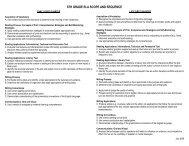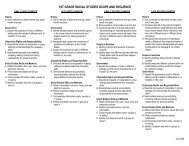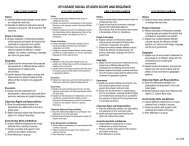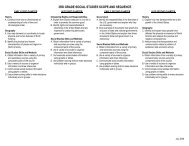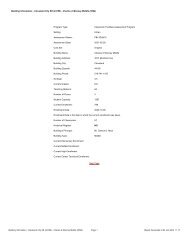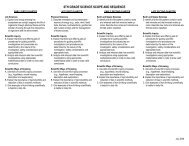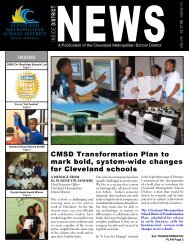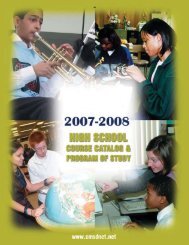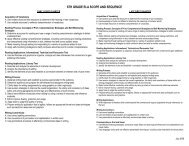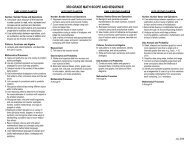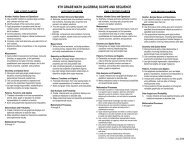1ST GRADE MATH SCOPE AND SEQUENCE
1ST GRADE MATH SCOPE AND SEQUENCE
1ST GRADE MATH SCOPE AND SEQUENCE
Create successful ePaper yourself
Turn your PDF publications into a flip-book with our unique Google optimized e-Paper software.
EARLY FIRST QUARTER<br />
<strong>1ST</strong> <strong>GRADE</strong> <strong>MATH</strong> <strong>SCOPE</strong> <strong>AND</strong> <strong>SEQUENCE</strong><br />
LATE FIRST QUARTER<br />
EARLY SECOND QUARTER<br />
LATE SECOND QUARTER<br />
Number, Number Sense and Operations<br />
A. Use place value concepts to represent whole<br />
numbers using numerals, words and<br />
physical models.<br />
B. Recognize, classify, compare and order<br />
whole numbers.<br />
F. Count, using numerals and ordinal numbers.<br />
G. Model, represent and explain addition as<br />
combining sets and counting on.<br />
H. Model, represent and explain subtraction as<br />
comparison, take-away and part-to-whole.<br />
Mathematical Processes<br />
A. Use a variety of strategies to understand<br />
problem situations; e.g., discussing with<br />
peers, stating problems in own words,<br />
modeling problems with diagrams or<br />
physical materials, identifying a pattern.<br />
B. Identify and restate in own words the<br />
question or problem and the information<br />
needed to solve the problem.<br />
C. Generate alternative strategies to solve<br />
problems.<br />
D. Evaluate the reasonableness of predictions,<br />
estimations and solutions.<br />
E. Explain to others how a problem was solved.<br />
F. Draw pictures and use physical models to<br />
represent problem situations and solutions.<br />
G. Use invented and conventional symbols and<br />
common language to describe a problem<br />
situation and solution.<br />
H. Recognize the mathematical meaning of<br />
common words and phrases, and relate<br />
everyday language to mathematical<br />
language and symbols.<br />
I. Communicate mathematical thinking by using<br />
everyday language and appropriate<br />
mathematical language.<br />
Number, Number Sense and Operations<br />
K. Demonstrate fluency in addition facts with<br />
addends through 9 and corresponding<br />
subtractions.<br />
Patterns, Functions and Algebra<br />
D. Model problem situations, using objects,<br />
pictures, numbers and other symbols.<br />
Data Analysis and Probability<br />
A. Pose questions and gathers data about<br />
everyday situations and familiar objects.<br />
B. Sort and classify objects by attributes, and<br />
organize data into categories in a simple<br />
table or chart.<br />
C. Represent data using objects, picture graphs<br />
and bar graphs.<br />
Mathematical Processes<br />
A. Use a variety of strategies to understand<br />
problem situations; e.g., discussing with<br />
peers, stating problems in own words,<br />
modeling problems with diagrams or<br />
physical materials, identifying a pattern.<br />
B. Identify and restate in own words the<br />
question or problem and the information<br />
needed to solve the problem.<br />
C. Generate alternative strategies to solve<br />
problems.<br />
D. Evaluate the reasonableness of predictions,<br />
estimations and solutions.<br />
E. Explain to others how a problem was solved.<br />
F. Draw pictures and use physical models to<br />
represent problem situations and solutions.<br />
G. Use invented and conventional symbols and<br />
common language to describe a problem<br />
situation and solution.<br />
H. Recognize the mathematical meaning of<br />
common words and phrases, and relate<br />
everyday language to mathematical<br />
language and symbols.<br />
I. Communicate mathematical thinking by using<br />
everyday language and appropriate<br />
mathematical language.<br />
Geometry and Spatial Sense<br />
A. Describe and create plane figures: circle,<br />
rectangle, square, triangle, hexagon,<br />
trapezoid, parallelogram and rhombus, and<br />
identify them in the environment.<br />
B. Describe solid objects: cube, rectangular<br />
prism, sphere, cylinder, cone and pyramid,<br />
and identify them in the environment.<br />
C. Sort and compare two-dimensional figures<br />
and three-dimensional objects according to<br />
their characteristics and properties.<br />
D. Identify, explain and model (superposition,<br />
copying) the concept of shapes being<br />
congruent and similar.<br />
E. Recognize two- and three-dimensional<br />
objects from different positions.<br />
F. Describe location, using comparative (before,<br />
after), directional (above, below), and<br />
positional (first, last) words.<br />
G. Identify and draw figures with line symmetry.<br />
Data Analysis and Probability<br />
D. Describe the probability of chance events as<br />
more, less or equally likely to occur.<br />
Mathematical Processes<br />
A through I<br />
Number, Number Sense and Operations<br />
C. Represent commonly used fractions using<br />
words and physical models.<br />
Patterns, Functions and Algebra<br />
A. Sort, classify and order objects by size,<br />
number and other properties, and describe<br />
the attributes used.<br />
B. Extend sequences of sounds and shapes or<br />
simple number patterns, and create and<br />
record similar patterns.<br />
C. Create and extend patterns, and describe the<br />
rule in words.<br />
D. Model problem situations, using objects,<br />
pictures, numbers and other symbols.<br />
E. Solve open sentences and explain strategies.<br />
Mathematical Processes<br />
A. Use a variety of strategies to understand<br />
problem situations; e.g., discussing with<br />
peers, stating problems in own words,<br />
modeling problems with diagrams or<br />
physical materials, identifying a pattern.<br />
B. Identify and restate in own words the<br />
question or problem and the information<br />
needed to solve the problem.<br />
C. Generate alternative strategies to solve<br />
problems.<br />
D. Evaluate the reasonableness of predictions,<br />
estimations and solutions.<br />
E. Explain to others how a problem was solved.<br />
F. Draw pictures and use physical models to<br />
represent problem situations and solutions.<br />
G. Use invented and conventional symbols and<br />
common language to describe a problem<br />
situation and solution.<br />
H. Recognize the mathematical meaning of<br />
common words and phrases, and relate<br />
everyday language to mathematical<br />
language and symbols.<br />
I. Communicate mathematical thinking by using<br />
everyday language and appropriate<br />
mathematical language.<br />
July 2008
EARLY THIRD QUARTER<br />
<strong>1ST</strong> <strong>GRADE</strong> <strong>MATH</strong> <strong>SCOPE</strong> <strong>AND</strong> <strong>SEQUENCE</strong><br />
LATE THIRD QUARTER<br />
EARLY FOURTH QUARTER<br />
LATE FOURTH QUARTER<br />
Number, Number Sense and Operations<br />
A. Use place value concepts to represent whole<br />
numbers using numerals, words and<br />
physical models.<br />
F. Count, using numerals and ordinal numbers.<br />
Measurement<br />
A. Explain the need for standard units of<br />
measure.<br />
B. Select appropriate units for length, weight,<br />
volume (capacity) and time, using:<br />
• objects; i.e., non-standard units;<br />
• U.S. customary units: inch, foot, yard,<br />
ounce, pound, cup, quart, gallon, minute,<br />
hour, day, week and year;<br />
• metric units: centimeter, meter, gram and<br />
liter.<br />
Mathematical Processes<br />
A. Use a variety of strategies to understand<br />
problem situations; e.g., discussing with<br />
peers, stating problems in own words,<br />
modeling problems with diagrams or<br />
physical materials, identifying a pattern.<br />
B. Identify and restate in own words the<br />
question or problem and the information<br />
needed to solve the problem.<br />
C. Generate alternative strategies to solve<br />
problems.<br />
D. Evaluate the reasonableness of predictions,<br />
estimations and solutions.<br />
E. Explain to others how a problem was solved.<br />
F. Draw pictures and use physical models to<br />
represent problem situations and solutions.<br />
G. Use invented and conventional symbols and<br />
common language to describe a problem<br />
situation and solution.<br />
H. Recognize the mathematical meaning of<br />
common words and phrases, and relate<br />
everyday language to mathematical<br />
language and symbols.<br />
I. Communicate mathematical thinking by using<br />
everyday language and appropriate<br />
mathematical language.<br />
Number, Number Sense and Operations<br />
D. Determine the value of a collection of coins<br />
and dollar bills.<br />
E. Make change using coins for values up to<br />
one dollar.<br />
H. Model, represent and explain subtraction as<br />
comparison, take-away and part-to-whole.<br />
L. Demonstrate fluency in adding and<br />
subtracting multiples of 10, and recognize<br />
combinations that make 10.<br />
Measurement<br />
C. Develop common referents for units of<br />
measure for length, weight, volume<br />
(capacity) and time to make comparisons<br />
and estimates.<br />
D. Apply measurement techniques to measure<br />
length, weight and volume (capacity).<br />
Mathematical Processes<br />
A. Use a variety of strategies to understand<br />
problem situations; e.g., discussing with<br />
peers, stating problems in own words,<br />
modeling problems with diagrams or<br />
physical materials, identifying a pattern.<br />
B. Identify and restate in own words the<br />
question or problem and the information<br />
needed to solve the problem.<br />
C. Generate alternative strategies to solve<br />
problems.<br />
D. Evaluate the reasonableness of predictions,<br />
estimations and solutions.<br />
E. Explain to others how a problem was solved.<br />
F. Draw pictures and use physical models to<br />
represent problem situations and solutions.<br />
G. Use invented and conventional symbols and<br />
common language to describe a problem<br />
situation and solution.<br />
H. Recognize the mathematical meaning of<br />
common words and phrases, and relate<br />
everyday language to mathematical<br />
language and symbols.<br />
I. Communicate mathematical thinking by using<br />
everyday language and appropriate<br />
mathematical language.<br />
Number, Number Sense and Operations<br />
E. Make change using coins for values up to<br />
one dollar.<br />
G. Model, represent and explain addition as<br />
combining sets and counting on.<br />
L. Demonstrate fluency in adding and<br />
subtracting multiples of 10, and recognize<br />
combinations that make 10.<br />
Mathematical Processes<br />
A. Use a variety of strategies to understand<br />
problem situations; e.g., discussing with<br />
peers, stating problems in own words,<br />
modeling problems with diagrams or<br />
physical materials, identifying a pattern.<br />
B. Identify and restate in own words the<br />
question or problem and the information<br />
needed to solve the problem.<br />
C. Generate alternative strategies to solve<br />
problems.<br />
D. Evaluate the reasonableness of predictions,<br />
estimations and solutions.<br />
E. Explain to others how a problem was solved.<br />
F. Draw pictures and use physical models to<br />
represent problem situations and solutions.<br />
G. Use invented and conventional symbols and<br />
common language to describe a problem<br />
situation and solution.<br />
H. Recognize the mathematical meaning of<br />
common words and phrases, and relate<br />
everyday language to mathematical<br />
language and symbols.<br />
I. Communicate mathematical thinking by using<br />
everyday language and appropriate<br />
mathematical language.<br />
Number, Number Sense and Operations<br />
I. Model, represent and explain multiplication as<br />
repeated addition, rectangular arrays and<br />
skip counting.<br />
J. Model, represent and explain division as<br />
sharing equally, repeated subtraction and<br />
rectangular arrays.<br />
Mathematical Processes<br />
A. Use a variety of strategies to understand<br />
problem situations; e.g., discussing with<br />
peers, stating problems in own words,<br />
modeling problems with diagrams or<br />
physical materials, identifying a pattern.<br />
B. Identify and restate in own words the<br />
question or problem and the information<br />
needed to solve the problem.<br />
C. Generate alternative strategies to solve<br />
problems.<br />
D. Evaluate the reasonableness of predictions,<br />
estimations and solutions.<br />
E. Explain to others how a problem was solved.<br />
F. Draw pictures and use physical models to<br />
represent problem situations and solutions.<br />
G. Use invented and conventional symbols and<br />
common language to describe a problem<br />
situation and solution.<br />
H. Recognize the mathematical meaning of<br />
common words and phrases, and relate<br />
everyday language to mathematical<br />
language and symbols.<br />
I. Communicate mathematical thinking by using<br />
everyday language and appropriate<br />
mathematical language.<br />
July 2008




